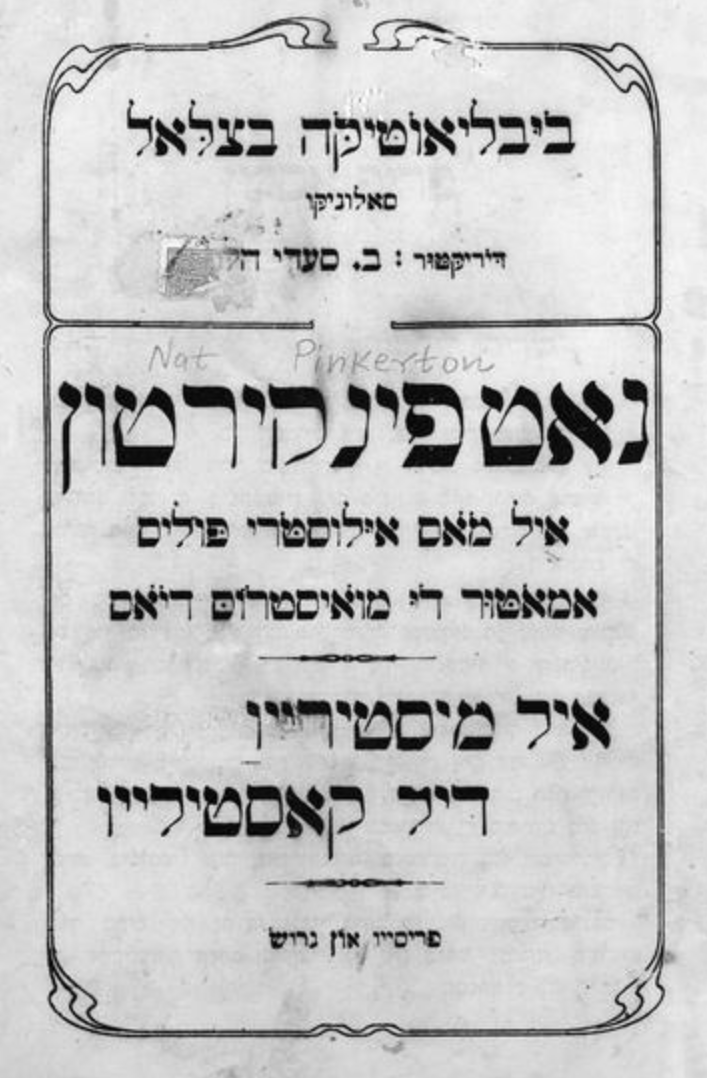This blog post continues to explore the revival of Ladino literature. One of the literary genres that captivated Ladino readers in the modern era was the detective novel.
Crime and detective fiction originated in Western Europe. In the eighteenth century, Western literature became increasingly preoccupied with criminality, both in detective stories and sensation drama, such as the Victorian-era “penny-dreadful” novels. Crime also figured prominently in canonical literature written by authors such as George Elliot and Charles Dickens. Perhaps the most well-known representative of this genre was Sir Arthur Conan Doyle’s Sherlock Holmes. The point at which crime becomes central to popular modes of narrative coincide loosely with the advent of modernity, that is, the 300 years stretching from the eighteenth to the twenty-first century, when life became progressively more urban, more shaped by technology, more individualist, and beholden to the aspirations and tensions of the “Enlightenment Project.” In his study of literary representation of crime, scholar Linden Peach describes criminality is an inversion of the ideals of modernity, capable of mimicking features of capitalism. According to Peach, literary depictions of criminality are symbols of the failures of modernity.
Most of the known Ladino detective novels were published in Salonica (today’s Thessaloniki), one of the main hubs of Ottoman Jewish print culture. Similarly to the publications in Europe, Ladino detective stories usually appeared as series centered on the character of a detective that reappeared to solve new crime mysteries. In 2014, scholar Julie Scolnik published a study of one such series, Nat Pinkerton, which features ten novels translated from Ladino to Spanish. In Nat Pinkerton: Diez Novelas Policíacas en Lengua Sefardi, Scolnik introduces the Ladino corpus of detective stories, alongside a glossary of Ladino words as well as the locations where the stories take place. While this study is in the Spanish language, Scolnik’s English-language article, “The Detective Novel in Ladino” (2010) provides a shorter introduction to the topic, with several examples from the texts.

The cover of a "Nat Pinkerton" novel in Ladino, published in Salonica in 1912 by Biblioteka Betsalel.
The Ladino corpus of Nat Pinkerton contains over twenty novels. Most of them were published in Salonica by Biblioteka Betsalel and edited by the publisher, Besalel Sa’adi Halevi, the son of Betsalel Sa’adi Halevi (1819-1903), the well known publisher and journalist whose memoir was translated by Sarah Abrevaya Stein and Aron Rodrigue (2012). The story of the Halevi family is also explored in Sarah Abrevaya Stein 2019 book, Family Papers.
Interestingly, “Pinkerton” was the name of a real detective agency, The Pinkerton National Detective Agency, that was established in Chicago in 1850 and that operates to this day as a security firm. The detective’s character was modeled after the firm’s founder, Allan Pinkerton (1819-1884), who immigrated to the US from Scotland in 1842. To read more about the “real” Pinkerton, check out Jane Hunter’s 2002 study, Clock and Dollar: A History of American Secret Intelligence.
While the history of Pinkerton may suggest that his literary depictions evolved in America, the Nat Pinkerton novels were first written in German. The first editions were kept in municipal libraries and destroyed in the bombings of the Second World War. These texts lived on in translation, and Ladino was only one of many languages that adopted and adapted Pinkerton’s tales. One example of Pinkerton’s illustrious afterlife is the staggering popularity of the novels in early-twentieth century Russia, which was examined in Boris Dralyuk’s 2012 study, Western Crime Fiction goes East: The Russian Pinkerton Craze 1907-1934.